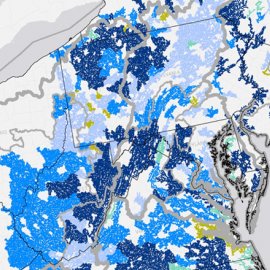Fresh Water Springs and the Ocean
-
English
-
ListenPause
Welcome to World Ocean Radio… I’m Peter Neill, Director of the World Ocean Observatory. Our planet is a sphere that is 70% covered by the ocean. That ocean, however, is not limited to the sea itself but rather begins at the mountaintop and descends to the abyssal plain, a network of falling watersheds to the sea that encompasses a system of cycles of conveyance is the ocean/freshwater continuum, that draws waterlines across all facets of the surface of the earth. These are all circles of connection. Our planet is Aqua, not Terra, and we are all water, now and forevermore. As I have argued often before, this water system lies at the heart of our strategy for human survival in the 21st century. If we fail to sustain it, we fail to sustain ourselves. It is so urgent and obvious. Three days without oil or gas or coffee or chocolate, and we carry on, deprived and grouchy, but three days without water, as individuals, families, communities, or nation-states, we die. But where in this collective of circles can we point to a place where the ocean begins? Consider springs, those hidden seeps and sources of water from the inside of the earth that rise from the core to the ground, and even to the ocean floor, to feed our puddles, ponds, lakes, streams and rivers, our swamps and coastal marshes, our bays and seas. From these tiny fonts comes a flow that like a skein of veins and arteries distributes water into our bodies, our foods, our manufacturing systems, and all the other social and financial dynamics of our lives. What starts so small ends up so vast. By the shore we see the fulsome expanse of open water, but inland we may never know even where the spring sources lie, where they come and go, where they should be mapped, studied and protected, where they fit into this enormous water cycle that sustains us. I was delighted recently to be introduced to the Spring Stewardship Institute, a program based at the Museum of Northern Arizona in Flagstaff, developed and directed by Dr. Larry Stevens as a local initiative to advance research and springs ecosystems on the Colorado Plateau in the United States and around the world. The goals are similar to other such academic projects: identification, location mapping, research, standards for stewardship, training, publication, educational outreach, results, workshops, webinars, and online presence and connection. But, in this case, it is the focus of this effort that is to be communicated, novel and meaningful as a piece of the water study circle unexamined and vulnerable. For purposes of our understanding today, let’s declare that springs are that point of origin for all that follows in terms of study, protection, and sustainability of the world’s ocean and water resources. Can you participate? Well, yes you can. The Institute, in collaboration with the US National Parks Service, Bureau of Land Management, and ESRI, a developer of mapping and analytics software, has created an app that provides a tool whereby to map spring locations, add new ones, provide on-the-ground information, keep current sites up-to-date, and add a new location anywhere in the world – all through your smart phone in the field. This is an amazing tool for citizen science, educational field trip engagement, portable access to comparative data and information, and crowd-sourced research in places where no single expedition or researcher can practically go. While the visual inventory on the site maps is concentrated in the Desert Southwest – there are more than 90,000 springs in the current database! New ones are being added every day that provide coordinates, photographs, iconography, and various information protocols that collectively provide an enormous knowledge base for study, management, and protection created in an astonishingly short period of time by a spontaneous, diverse and multiplying international team of researchers: you and me. All of us know springs in our surrounding environments. Let’s add those to this responsible accumulation. Think about the full aggregation, the full inventory of all these places of origin for the water that makes our ocean and all that it provides. It is the definition of the ocean itself, and you are the researchers. We will discuss these issues, and more, in future editions of World Ocean Radio. - - - WORLD OCEAN RADIO IS DISTRIBUTED BY THE PUBLIC RADIO EXCHANGE AND THE PACIFICA NETWORK FOR USE BY COLLEGE AND COMMUNITY RADIO STATIONS WORLDWIDE. FIND US WHEREVER YOU LISTEN TO YOUR FAVORITE PODCASTS. IF YOU VALUE WORLD OCEAN RADIO, PLEASE CONSIDER BECOMING A PATREON SUPPORTER TODAY. VISIT WORLDOCEANOBSERVATORY DOT ORG.
This week on World Ocean Radio we talk about springs, those fresh water seeps that serve as an integral part of the earth's water system. We introduce listeners to a new app, Hide and Seep, developed by the Spring Stewardship Institute in collaboration with the US National Parks Service Bureau of Land Management and ESRI. Hide and Seep is a mapping software tool that allows citizen scientists to locate water sources and add them to a vast database of fresh water springs.
About World Ocean Radio
Peter Neill, Director of the World Ocean Observatory and host of World Ocean Radio, provides coverage of a broad spectrum of ocean issues from science and education to advocacy and exemplary projects. World Ocean Radio, a project of the World Ocean Observatory, is a weekly series of five-minute audio essays available for syndicated use at no cost by college and community radio stations worldwide.
If you value World Ocean Radio, please consider becoming a Patreon Supporter today.
Image Credit
Conservation International
References from this Episode
< Springs Stewardship Institute
< Esri
< US National Parks Service, Bureau of Land Management
< Hide and Seep app
- Login to post comments



